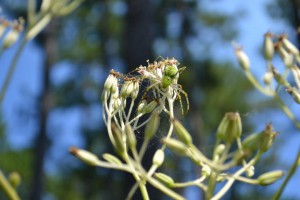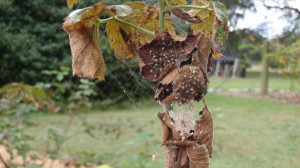Take a walk through the garden or woods this fall and you are sure to pass by a Green lynx spider. Unless you are very observant though, you will probably not realize that this common spider is perched upon flowers and low shrubs, ready to catch an insect meal.

Even though Green lynx spiders are very large, they are often well camouflaged in plant material. Spiders are bright green with a lighter color on the abdomen including some small red markings. The legs have distinctive black spines.
This spider does not spin a web but actively hunts insects using a dragline as it quickly moves or jumps over plants. It is an opportunistic feeder catching many types of insects that are visiting flowers. It has been noted as an important predator of some crop damaging insects.
Females will normally lay one egg sac in the fall and guard it from predators. It is constructed in the upper portions of branches and has webbing connecting it to nearby plant leaves. This webbing becomes a protective area for the emerged spiderlings until they are able to take care of themselves.
Lynx spiders pose no harm to people and should be considered one of many beneficial arthropods that we see in Florida.

 0
0
